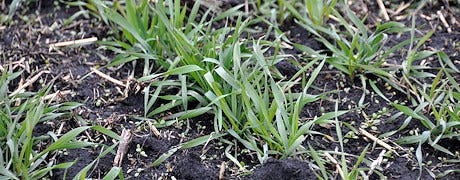
If the widespread drought of 2012 taught farmers anything, it is the value of crop resilience. And nowhere did that resilience show up more than in quality, long-term no-till fields.
The key word is quality, says Barry Fisher, state soil health specialist for the Natural Resources Conservation Service in Indiana.
"There is more to no-till than just stopping tillage," Fisher says. "Advanced nutrient management has to complement the system with a prescribed cover crop mix being part of the way you meet goals and objectives."
Fisher says the rules of managing for maximum soil health and fertility apply to all crops, not just corn and soybeans.

BEATING DROUGHT: Turns out in conservation farming, crops do better. Cover crops help.
For 200 years, Fisher says, scientists have primarily concentrated on the chemistry and physical properties of the soil, ignoring the biology.
"Only in the last few decades have we concentrated on the soil's living microbes and their role in soil health and fertility," he says. "Now we know that the key to soil quality is its functional ability to support optimal biological activity. And we know that soil health is its capacity to serve as a vital living system, supporting a thriving environment for the microbes that live there."
Building a conservation cropping system is all about adding more organic matter to the soil and about giving corn and soybean roots a variety of pathways to reach water and nutrients deeper into the soil.

HEALTHIER SOIL: Indiana soil health specialist Barry Fisher says cover crops, no-till establish better soil health to combat drought.
"We used to say that the top three or four inches of soil were the most important because the corn roots didn't go any deeper than that," he says. "Now, we are learning that if you build channels that go deeper and pathways those roots can take they will go deeper. And if you have organic matter deeper, you will have water and nutrients deeper into the soil."
Those deeper roots and deeper nutrients are what provide resilience for the crop to withstand drought, he says. That resilience provided one Indiana no-till farmer with a yield of more than 200 bushels to the acre in the severe drought of 2012.
Four step plan
Fisher offers a four step plan for farmers interested in a soil health cropping system.
Step 1: No-till a cereal rye cover crop into corn stalks. Rye is easy to establish and easy to kill; is cold tolerant and is tolerant to residual corn herbicides. It can be aerial seeded, incorporated with a vertical tillage tool or drilled successfully. It can also be missed with other species such as daikon radish or rape.
Step 2: No-till a relatively early group soybean into the cereal rye and plant those beans early. Early planting and harvest provides a wider window for a fall cover crop mix.
Step 3: Plant a low carbon to nitrogen cover crop mix after the soybeans. You should choose cover crops that provide nutrients you know your following crop (in this case, corn) will need. Crops that trap or produce nitrogen in the fall and early spring and release it in the spring and summer are ideal. A mix such as oats and daikon radish that winter kills or annual ryegrass and crimson clover mix will work well.
Step 4: No-till corn into the cover crop mix the following spring. This makes the no-till corn the fourth operation on the soil and gives the advantages of a soil that already has many of the soil health qualities of a mature system. Soil biological populations are well on their way, aggregates are stabilizing and pores are opening. And the cover crop mix is ready to provide a timed release of organic nitrogen to the corn crop.
Fisher says it is important to realize that feeding the future population of the world will require genetic and technological advancements in addition to healthy soils.
"But those advancements provide the greatest benefit when the soil is healthy," he says.
--Griekspoor writes for sister publication Kansas Farmer
About the Author(s)
You May Also Like




